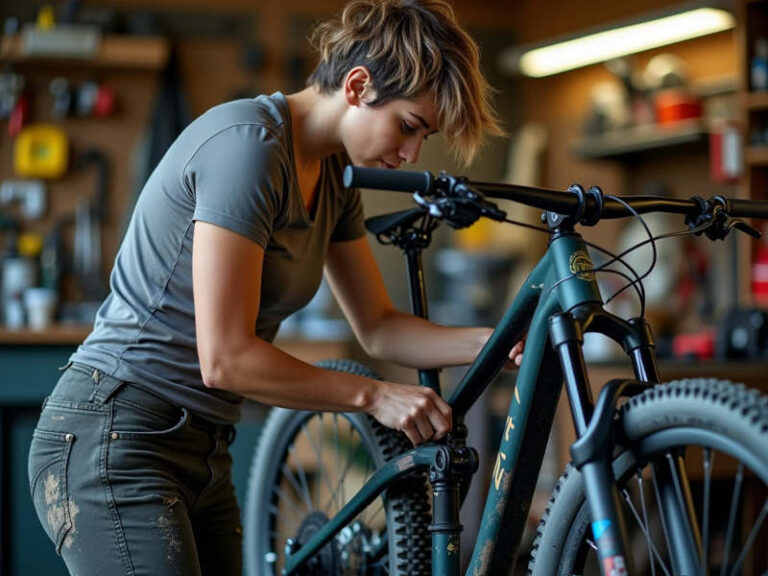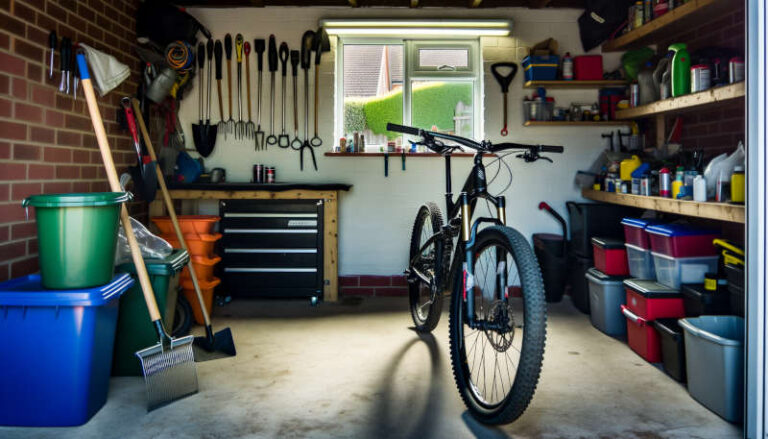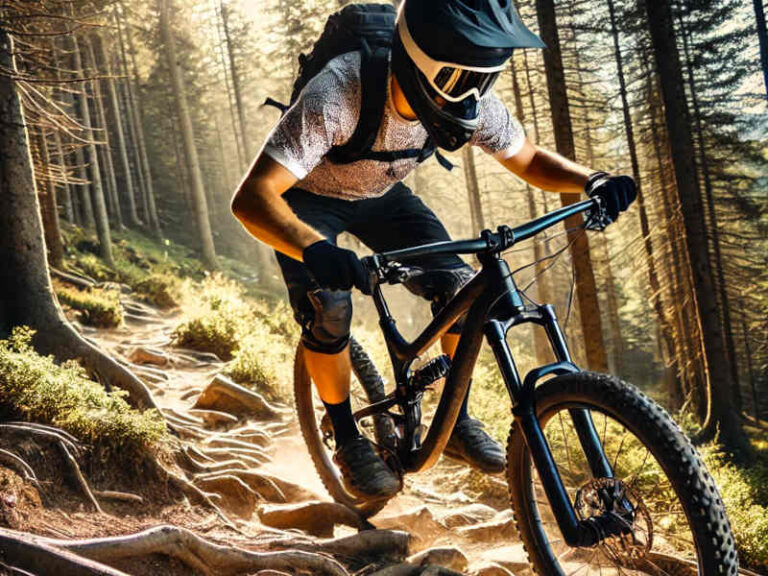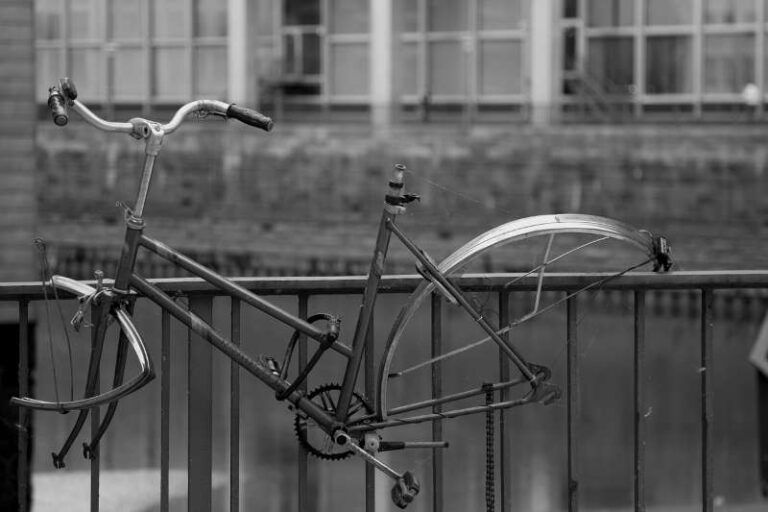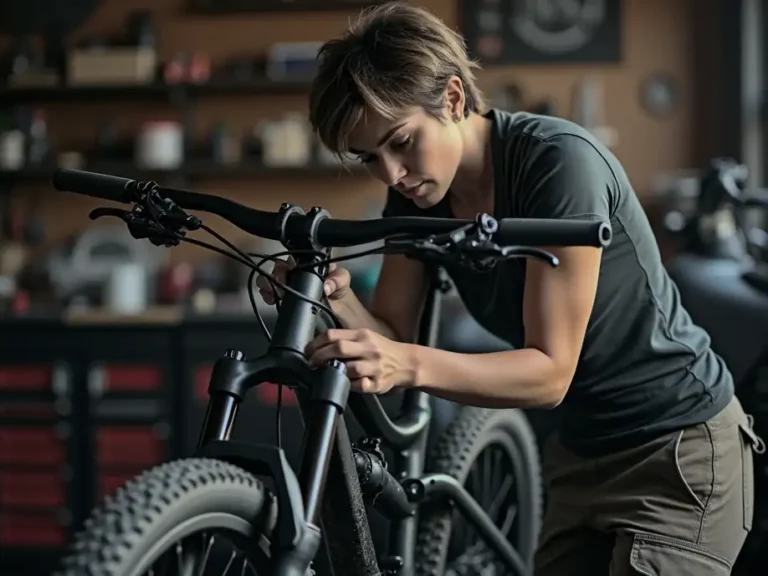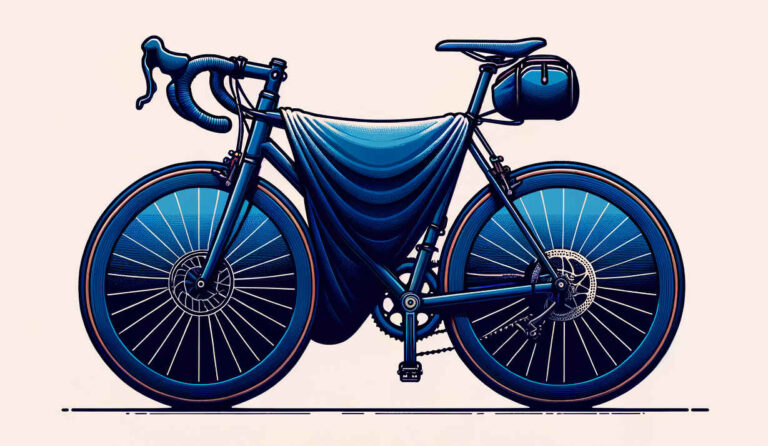Essential Bike Theft Prevention and Recovery Tips Every Cyclist Should Know
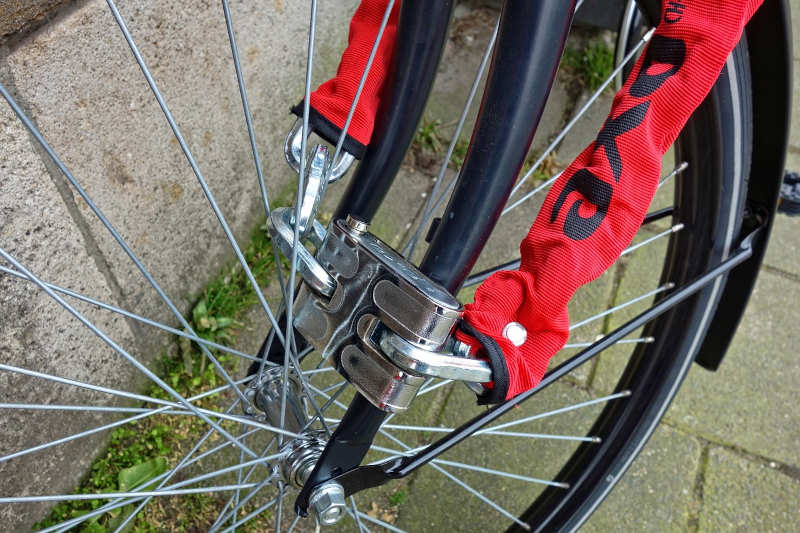
It is a total downer to get your bike stolen. Unfortunately, bike theft is a growing problem, especially with the increasing number of expensive high-end bikes and e-bikes around making it more tempting for thieves to steal.
Some interesting and startling statistics highlighting the issue are listed at Project 529 Garage including:
- over 2 million bikes in North America are stolen annually
- this equates to two bikes stolen every minute, resulting in over 1 billion dollars worth of loss
- fewer than 5% of stolen bikes are returned to their owners
- in over half the thefts, only a single cable lock was used to secure the bike
- 80% of bike owners don’t know their bike’s serial numbers, and less than 1% of bikes are registered
- only about 20% of people report their stolen bike to the police
Square One Insurance Services’ data confirms that less than 5% of stolen bikes are recovered to their owners in some Canadian cities.
Doesn’t paint a very nice picture, does it? Bike theft is definitely a problem, and so is recovery of bikes. Ignoring the problems won’t make them go away though. There are many proactive steps you can take to help with both issues.
What you can do to help in the recovery of your bike if it’s stolen:
Take measures to properly record your information:
Whether you’ve just purchased a new bike or had one for years, as you can see from the information above, the VERY least you should do is record your serial number in one or more secure places. If you don’t know your serial number, you’ll have a really hard time proving your bike is yours and getting it back.
So where can you find your serial number? There are several places on your bike it can be located. The Saskatoon Police department has this handy diagram of places it’s most often located:
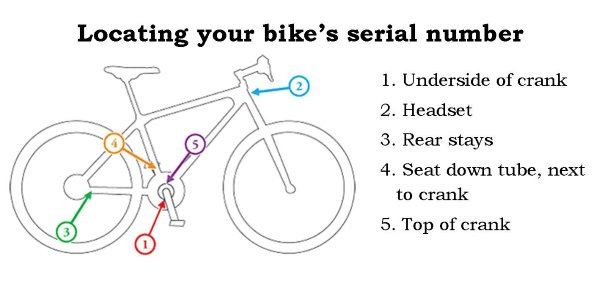
Image source: Saskatoon Police Department
Write it down and save it in a place you’ll remember, such as in a folder in a filing cabinet and/or save it on your computer or phone.
Make note of the bike make, model, color and type of bike. You might think it’s a no-brainer that you’ll remember all these things, but it’s funny how our eyes can brush over something we use every day and it’s not until we need it that we realize that we really don’t know.
Keep the sales receipt in a secure place and also take a copy or photo of it for back-up. If you purchase a used bike, ask for a bill of sale so you have a record of the transaction.
Take photos of your bike and make note of any identifying marks or custom parts. Include yourself in some of the photos as it helps link your bike with you as the owner.
Take it further and register your bike with an official bike registry. This is a vital step and it is best is to register your bike at the service your local police force recommends. Some police forces use their own bike registry, some have partnered with outside registry services, some recommend using a particular service. It differs in cities across the nation.
Registries Cities/Police use across Canada:
Here’s a handy list of registries used in some of the larger Canadian cities (in alphabetical order)
| City | Registry used |
| Calgary | Bike Index |
| Charlottetown | Their own Charlottetown police registry |
| Edmonton | Bike Index |
| Fredericton | Project 529 Garage – Fredericton |
| Halifax | Project 529 Garage – Halifax |
| Kamloops | Project 529 Garage – Kamloops |
| Kelowna | Project 529 Garage – Kelowna |
| Lethbridge | Bike Index |
| Montreal | Project 529 Garage – Montreal |
| Nanaimo | Project 529 Garage – Nanaimo |
| Ottawa | Project 529 Garage – Ottawa |
| Prince George | Project 529 Garage – Prince George |
| Quebec City | Project 529 Garage – Quebec |
| Red Deer | Project 529 Garage – Red Deer |
| Regina | Project 529 Garage – Regina |
| Saskatoon | Their own Saskatoon police registry |
| Toronto | Their own Toronto police registry |
| Vancouver | Project 529 Garage – Vancouver |
| Victoria | Project 529 Garage – Victoria |
| Winnipeg | Their own Winnipeg police registry |
Report it: In the unfortunate event that your bike gets stolen, you (of course) need to report the theft to the police so you have a chance if it being returned to you if they find it. If you’ve followed all of the above tips, tell the police about where you registered it and/or share with them all the details you recorded as well as your receipt and photos.
Stickers – Bike Index: If you live in Calgary, Edmonton or Lethbridge, you can pick up a Bike Index sticker at a police station to put on your bike which has a unique identifier and which can aid in deterring would-be thieves.
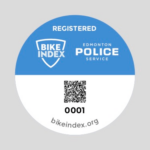
Stickers – Project 529: For cities using Project 529 Garage, sticker decals for your bike are often available at police stations and other locations across Canada. Find information on this here: project529.com/garage/shop, or you can purchase one online through the Central Alberta Crime Prevention Centre.
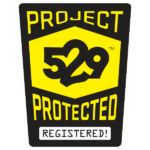
Ottawa stats: Live in Ottawa? You can access some very interesting data through the Ottawa police about bike thefts from 2016 to 2022. For example, to the right is a map of locations of Ottawa bike thefts that occurred during those years, so you can see where in the city your risk of theft increases and where you need to be more proactive. You can also access and refine a large amount of other information including bike types, models, value, etc

Feel safer in a small town? Interestingly, if you think you’re bike’s safer because you live in a small town, you might be surprised! Stats by The Best Bike Lock show that smaller cities in Canada have more bike thefts per capita, so stay frosty and be proactive
Think your bike’s safer at your home? Think again! 43.4% of bikes were stolen from residential properties from 2016 to 2022 across 5 major Canadian cities, says Square One often from sheds or garages.
We tend to relax around our own home, and maybe a bit too much when it comes to bike security. Being diligent in securing your bike at home can make a difference.
Police from across Canada agree that if you see your stolen bike listed in classified ads etc, DO NOT make contact with the seller. Notify the police immediately and let them handle it.
Proactive steps to take to help to prevent your bike from being stolen in the first place
Tips for locking your bike
There are lots of measures you can take to help avoid losing your bike to a thief, including where and how to lock your bike. It’s not a nice thought, but if a thief has all the time and tools in the world, they WILL be able to steal your bike, so reduce their chances by following some guidelines. If your bike is less easy to steal than the guy’s next to you, you’re less of a target (sorry guy parked next to you).
Use something stronger than a cable lock: Most cable locks can be cut very quickly with bolt cutters, which is the reason over 50% of bike thefts involved a single cable lock. Better choices are hardened steel chains, u-locks and folding locks, however each of those have weaker and better versions so educate yourself on the differences.
Lock your bike to something strong: Give some thought as to what you are locking your bike to. It may be easier for thieves to cut through or break the structure you’re locking your bike TO than your bike lock or chain itself, so be aware of this and when possible lock your bike to something as strong or stronger than your lock/chain.
Make sure the bike rack or other item is firmly secured: If a bike rack is not secured well to the ground or another solid structure, it is not much good with respect to thieves who can throw your bike, along with the rack, into their truck and drive away. They then have all the time in the world to cut your bike away from the rack in the comfort of their own home. This might seem unlikely, but for a bike worth thousands of dollars, thieves may go that extra mile.
Lock your bike in a visible, well lit, busy area whenever possible: Bike thieves don’t like prying eyes as it’s more likely they will be noticed or caught, so the busier the area is, the less likely your bike will be stolen. And if possible, don’t lock your bike in the same spot for a number of consecutive days, especially in spots with low foot traffic, to avoid criminals noticing a pattern and planning their theft.
It’s a good idea to lock your frame to something, and toalso lock at least one wheel with a separate lock – here’s why: If you only secure your frame to something, a thief can break the lock or the item your lock is attached to and they can ride away on it. Your bike acts like a built-in get-away vehicle! BUT if the front or back wheel is also locked to your bike frame with a separate lock (like a U-lock), then there’s no riding it away. They would have to get through another lock or would have to carry your bike away, which is a lot less likely unless the thieves have a truck nearby. Even better for the second lock would be to lock both a wheel and your frame to the bike rack because they’d have to get through two locks right on location. That, however requires two long locks which is more cumbersome to carry, so for some people isn’t ideal. And another way to ‘kick it up’ EVEN better is if the first system you are using to lock your frame to something also goes around your other wheel. Then no wheels will be easily stolen either.
Bike locks
You need to be aware that NO lock is completely invulnerable – it’s just a matter of degree.
Have a lock that you think is rock solid against someone picking it? Think again! Visit The Lock Picking Lawyer on YouTube to see him picking almost every kind of lock imaginable. He has some informative and really fascinating videos about the vulnerabilities of locks. Be warned that watching his videos might make you feel – like I did – very discouraged when you see that pretty much any lock can be picked. But there are a couple of things about that to keep in mind:
First is that he has very specialized tools (some that he’s had specialty made) as well as incredible lock-picking skills. I would wager the vast majority of bike thieves don’t have his skills or resources.
Second is that lock-picking takes time, and that draws attention. This is another reason it’s important to lock your bike in a busy area rather than an isolated one.
What we found most helpful about the Lock Picking Lawyer videos are the ones showing locks that have an exceptionally easy vulnerability to pick. For example, a lock whose mechanisms can be overridden with a simple 5 second maneuver due to manufacturing oversights. These are locks to definitely avoid. It’s a good idea to do a search on his YouTube channel to see if your current bike lock, or one you are considering buying, has an easy vulnerability like that.
Portable Grinders have Changed the Game
U-locks and hardened steel chains are better choices than cables, and you can do your homework to find the strong ones on the market. But you need to be aware that the invention of portable cordless grinders have greatly increased the challenge of keeping your bike safe with almost any lock or chain nowadays. High-end e-bikes that cost thousands of dollars have become big targets. It can take as little as 1-2 minutes for a grinder to rip through a standard U-lock.
So locks can be picked and grinders can chew through tough u-locks and chains…doesn’t paint a very hopeful picture of keeping your bike safe, does it?!
Multiple locks and additional deterrent measures
As we’ve discussed above, it’s best to have at least two locks: one to secure your frame and one to lock your front or back wheel to your frame (and to the bike rack if possible). Grinders do make noise, so again, locking your bike where there’s lots of foot traffic and ‘eyes-on’ can help deter thieves using grinders.
You can also consider adding a sound alarm. What is this? It is an audible alarm that goes off if someone is causing movement to your bike, and is useful to scare away thieves by drawing attention to them.
So here’s scenario to consider: have a u-lock or thick high strength chain to lock your frame and one wheel to a very sturdy bike rack or structure using a heavy duty keyed lock, plus have a u-lock to secure the front and/or back wheel to the frame and (ideally) the bike rack, and a sound alarm to help scare away thieves by drawing attention to them.
Yes this does add weight to your bike, which is unfortunate so you’ll have to balance your priorities. Hip-lock chains can be worn around your hip, making it easier to take with you. For e-bike riders, the electric assist can compensate for the weight of multiple locks.
As mentioned above, there are still no guarantees your bike will be completely safe from theft, but it helps decrease the risk.
Some very creative new locks have been arriving on the market or coming soon, some only available in the USA at this point. One is the ‘Stink’ lock where cutting into it releases an extremely stinky gas (think skunk). Another way to deter a thief! But they may not be legal in all areas, so check before you buy.
Make sure you’re covered
In addition to the above measures, you can also get bike insurance for those instances where thieves get the better of you. Check what bike coverage your house or renters insurance might provide.
Sometimes your bike will be covered at replacement value for the bike at the time it was stolen (ie – what the market value is considering the age of your bike) and NOT what it would be to buy an equivalent new bike today. Sometimes it won’t be covered at all. Sometimes your deductible is high and you won’t ending up getting much above it. So make sure you check with your insurance company, and if it’s not covered, you might be able to pay for an insurance rider that will cover the replacement cost for a new bike equivalent to what your old bike was. But don’t necessarily jump at adding a rider: first consider the yearly cost of the rider and whether it’s worth it in the long term. Some insurance riders can be very costly annually.

by: Cory Willins
Cory is a dynamic and passionate content writer, specializing in sports-related topics. With over a decade of experience in the field, Cory has established… read more

